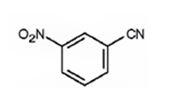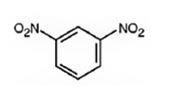
a) Bromobenzene
Interpretation:
The major product(s) formed when bromobenzene is nitrated is to be given. Whether it will react faster or slower than benzene is also to be stated.
Concept introduction:
Monosubstituted benzenes can be nitrated using a mixture of Conc. HNO3 and H2SO4. Electron releasing substituent groups, excep halogens, activate the ring and direct the incoming electrophile to the o- and p-positions. Compounds with these substituent groups are more reactive than benzene. Halogens are o- and p-directors but they deactivate the ring. Hence halobenzenes are less reactive than benzene. Electron withdrawing substituent groups deactivate the ring and direct the incoming electrophile to the m-position. Compounds with these substituent groups are less reactive than benzene.
To give:
The major products formed when bromobenzene is nitrated and to state whether it will react faster or slower than benzene.
Answer to Problem 47AP
The major products formed when bromobenzene is nitrated are o-bromonitrobenzene and p-bromonitrobenzene.

Bromobenzene will react slower than benzene.
Explanation of Solution
Bromine is an o- and p-directing group. It also has considerable electron withdrawing inductive effect which deactivates the ring. Hence bromobenzene is less reactive than benzene.

The major products formed when bromobenzene is nitrated are o-bromonitrobenzene and p-bromonitrobenzene.

Bromobenzene will react slower than benzene.
b) Benzonitrile
Interpretation:
The major product(s) formed when benzonitrile is nitrated is to be given. Whether it will react faster or slower than benzene is also to be stated.
Concept introduction:
Monosubstituted benzenes can be nitrated using a mixture of Conc. HNO3 and H2SO4. Electron releasing substituent groups, except halogens, activate the ring and direct the incoming electrophile to the o- and p-positions. Compounds with these substituents are more reactive than benzene. Halogens are o- and p-directors but they deactivate the ring. Hence halobenzenes are less reactive than benzene. Electron withdrawing substituent groups deactivate the ring and direct the incoming electrophile to the m-position. Compounds with these substituents are less reactive than benzene.
To give:
The major products formed when benzonitrile is nitrated and to state whether it will react faster or slower than benzene.
Answer to Problem 47AP
The major product formed when benzonitrile is nitrated is m-nitrobenzonitrile.

Benzonitrile will react slower than benzene.
Explanation of Solution
The cyanide group is strongly electron withdrawing in nature. Hence it is a meta director. The attraction of electrons away from the ring reduces the electron density in the ring. Thus benzonitrile reacts slower than benzene.

The major product formed when benzonitrile is nitrated is m-nitrobenzonitrile.

Benzonitrile will react slower than benzene.
c) Benzoic acid
Interpretation:
The major product(s) formed when benzoic acid is nitrated is to be given. Whether it will react faster or slower than benzene is also to be stated.
Concept introduction:
Monosubstituted benzenes can be nitrated using a mixture of Conc. HNO3 and H2SO4. Electron releasing substituent groups, except halogens, activate the ring and direct the incoming electrophile to the o- and p-positions. Compounds with these substituents are more reactive than benzene. Halogens are o- and p-directors but they deactivate the ring. Hence halobenzenes are less reactive than benzene. Electron withdrawing substituent groups deactivate the ring and direct the incoming electrophile to the m-position. Compounds with these substituents are less reactive than benzene.
To give:
The major products formed when benzoic acid is nitrated and to state whether it will react faster or slower than benzene.
Answer to Problem 47AP
The major product formed when benzoic acid is nitrated is m-nitrobenzoic acid.

Benzoic acid will react slower than benzene.
Explanation of Solution
The C=O in carboxyl group is strongly electron withdrawing in nature. Hence it is a meta director. The attraction of electrons away from the ring reduces the electron density in the ring. Thus benzoic acid reacts slower than benzene.

The major product formed when benzoic acid is nitrated is m-nitrobenzoic acid.

Benzoic acid will react slower than benzene.
d) Nitrobenzene
Interpretation:
The major product(s) formed when nitrobenzene is nitrated is to be given. Whether it will react faster or slower than benzene is also to be stated.
Concept introduction:
Monosubstituted benzenes can be nitrated using a mixture of Conc. HNO3 and H2SO4. Electron releasing substituent groups, except halogens, activate the ring and direct the incoming electrophile to the o- and p-positions. Compounds with these substituents are more reactive than benzene. Halogens are o- and p-directors but they deactivate the ring. Hence halobenzenes are less reactive than benzene. Electron withdrawing substituent groups deactivate the ring and direct the incoming electrophile to the m-position. Compounds with these substituents are less reactive than benzene.
To give:
The major products formed when nitrobenzene is nitrated and to state whether it will react faster or slower than benzene.
Answer to Problem 47AP
The major product formed when nitrobenzene is nitrated is m-dinitrobenzene.

Nitrobenzene will react slower than benzene.
Explanation of Solution
The nitro group is strongly electron withdrawing in nature. Hence it is a meta director. The attraction of electrons away from the ring reduces the electron density in the ring. Thus nitrobenzene reacts slower than benzene.

The major product formed when nitrobenzene is nitrated is m-dinitrobenzene.

Nitrobenzene will react slower than benzene.
e) Benzenesulfonic acid
Interpretation:
The major product(s) formed when benzenesulfonic acid is nitrated is to be given. Whether it will react faster or slower than benzene is also to be stated.
Concept introduction:
Monosubstituted benzenes can be nitrated using a mixture of Conc. HNO3 and H2SO4. Electron releasing substituent groups, except halogens, activate the ring and direct the incoming electrophile to the o- and p-positions. Compounds with these substituents are more reactive than benzene. Halogens are o- and p-directors but they deactivate the ring. Hence halobenzenes are less reactive than benzene. Electron withdrawing substituent groups deactivate the ring and direct the incoming electrophile to the m-position. Compounds with these substituents are less reactive than benzene.
To give:
The major products formed when benzenesulfonic acid is nitrated and to state whether it will react faster or slower than benzene.
Answer to Problem 47AP
The major product formed when benzenesulfonic acid is nitrated is m-nitro benzenesulfonic acid.

Benzenesulfonic acid will react slower than benzene.
Explanation of Solution
The sulfonic acid group is strongly electron withdrawing in nature. Hence it is a meta director. The attraction of electrons away from the ring reduces the electron density in the ring. Thus benzenesulfonic acid reacts slower than benzene.

The major product formed when benzenesulfonic acid is nitrated is m-nitro benzenesulfonic acid.

Benzenesulfonic acid will react slower than benzene.
f) Methoxybenzene
Interpretation:
The major product(s) formed when methoxybenzene is nitrated is to be given. Whether it will react faster or slower than benzene is also to be stated.
Concept introduction:
Monosubstituted benzenes can be nitrated using a mixture of Conc. HNO3 and H2SO4. Electron releasing substituent groups, except halogens, activate the ring and direct the incoming electrophile to the o- and p-positions. Compounds with these substituents are more reactive than benzene. Halogens are o- and p-directors but they deactivate the ring. Hence halobenzenes are less reactive than benzene. Electron withdrawing substituent groups deactivate the ring and direct the incoming electrophile to the m-position. Compounds with these substituents are less reactive than benzene.
To give:
The major products formed when methoxybenzene is nitrated and to state whether it will react faster or slower than benzene.
Answer to Problem 47AP
The major products formed when methoxybenzene is nitrated are o-nitromethoxybenene and p-nitromethoxybenene.

Methoxybenzene will react faster than benzene.
Explanation of Solution
The methoxy group is electron releasing in nature. Hence it is an o- and p-director. The attraction of electrons towards the ring increases the electron density in the ring. Thus methoxybenzene reacts faster than benzene.

The major products formed when methoxybenzene is nitrated are o-nitromethoxybenene and p-nitromethoxybenene.

Methoxybenzene will react faster than benzene.
Want to see more full solutions like this?
Chapter 16 Solutions
ORGANIC CHEMISTRY W/OWL
- Can you explain how I get these here and show the steps plz?arrow_forwardGive the IUPAC name for this compound Hydrocarbon Condensed Formulas Hint C2H5 CH2CH3 expand that in all the formula Part A: (CH3)2CHCH(C2H5)CH2CH2CH3 Give the IUPAC name for this compound. Part B: CH2=C(C2H5)CH2CH2CH3 Give the IUPAC name for this compound. Part C: (CH3)2C=CHC(C2H5)=CH2 Give the IUPAC name for this compound. Part D: CH3C=CCH(C2H5)2 Give the IUPAC name for this compound. Part E: (CH3)3CC=CCH2CH=C(CH3)2arrow_forwardSelect/ Match the correct letter from the image below for the IUPAC names given below: A B C D 3 E F G H K L Part 1. 4-methylheptane For example.mmmm Answer Letter H _for part 1 Part 2. 2,4-dimethylhexane Part 3. 2,3-dimethylpentane Part 4. 2,2-dimethylhexane Part 5. 2-ethyl-1,1,3,3-tetramethylcyclopentane Part 6. 3-ethyl-2-methylpentanearrow_forward
- Can u show the process as to how to get these?arrow_forwardSketch the expected 'H NMR spectra for the following compound. Label all of the H's in the structure and the corresponding signal for the spectra you sketch. Make sure you include the integration value and the splitting pattern for each signal Indicate how many signals you would expect in the 13C NMRarrow_forwardUse IUPAC naming rules to name the following hydrocarbon compounds: CH2-CH3 | a) CH-CH-CH2-CH-CH-CH3 b) | CH2 CH3 | CH3 CH3 \ / C=C H 1 H CH2-CH3 c) d) CH=C-CH3 e) CH3-CH2-CH2-CH=CH-CH3 f) CH2=CH-CH2-CH=CH-CH3 g) CH3-CH2-C = C-CH2-CH3 h)arrow_forward
- Q5 Name the following : a. b. C. d. e.arrow_forward25. Predict the major product of the following reaction. 1 equivalent of each of the starting materials was used. H₂C CH3 CH3 H3C H3C H3C. CH2 + H3C. heat CH3 CH H.C. CH3 H.C H.C CH3 CH CH3 CH3 A B C Earrow_forwardFind chemical structures based on the below information. a) Chemical formula C6H8O Compound is aromatic plus has two 1H NMR peaks that integrated for 3 each that are singlets (it could have more peaks in the 1H NMR b) Chemical Formula: C6H100 Compounds is conjugated 'H NMR has a signal that integrates for 6 and is a doublet IR spectra has a signal at 1730 cm-1arrow_forward
- Jaslev Propose a synthesis of the following starting from benzene and any other reagents and chemicals. No mechanisms are required. Indicate the condition for each step plus the major product for each step. More than two steps are required. Step 1 Step 2 مہد Brarrow_forwardPart C: The line formula for another branched alkane is shown below. i. In the IUPAC system what is the root or base name of this compound? ii. How many alkyl substituents are attached to the longest chain? iii. Give the IUPAC name for this compound.arrow_forwardPart D: Draw the Structural Formula for 4-ethyl-2-methylhexane Part E. Draw the Structural Formula for 1-chloro-3,3-diethylpentane (Chloro = Cl)arrow_forward
 ChemistryChemistryISBN:9781305957404Author:Steven S. Zumdahl, Susan A. Zumdahl, Donald J. DeCostePublisher:Cengage Learning
ChemistryChemistryISBN:9781305957404Author:Steven S. Zumdahl, Susan A. Zumdahl, Donald J. DeCostePublisher:Cengage Learning ChemistryChemistryISBN:9781259911156Author:Raymond Chang Dr., Jason Overby ProfessorPublisher:McGraw-Hill Education
ChemistryChemistryISBN:9781259911156Author:Raymond Chang Dr., Jason Overby ProfessorPublisher:McGraw-Hill Education Principles of Instrumental AnalysisChemistryISBN:9781305577213Author:Douglas A. Skoog, F. James Holler, Stanley R. CrouchPublisher:Cengage Learning
Principles of Instrumental AnalysisChemistryISBN:9781305577213Author:Douglas A. Skoog, F. James Holler, Stanley R. CrouchPublisher:Cengage Learning Organic ChemistryChemistryISBN:9780078021558Author:Janice Gorzynski Smith Dr.Publisher:McGraw-Hill Education
Organic ChemistryChemistryISBN:9780078021558Author:Janice Gorzynski Smith Dr.Publisher:McGraw-Hill Education Chemistry: Principles and ReactionsChemistryISBN:9781305079373Author:William L. Masterton, Cecile N. HurleyPublisher:Cengage Learning
Chemistry: Principles and ReactionsChemistryISBN:9781305079373Author:William L. Masterton, Cecile N. HurleyPublisher:Cengage Learning Elementary Principles of Chemical Processes, Bind...ChemistryISBN:9781118431221Author:Richard M. Felder, Ronald W. Rousseau, Lisa G. BullardPublisher:WILEY
Elementary Principles of Chemical Processes, Bind...ChemistryISBN:9781118431221Author:Richard M. Felder, Ronald W. Rousseau, Lisa G. BullardPublisher:WILEY





